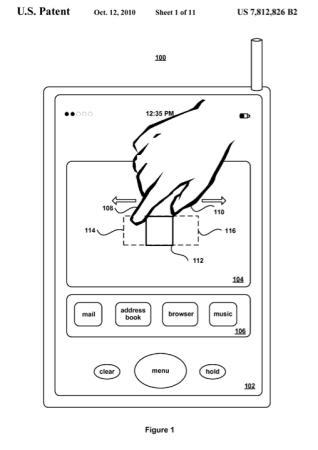Douglas Rushkoff nails my unease at the patenting of gestures, a critical front in the commercial war being waged through intellectual property. At stake is how far governments should grant monopoly rights over something that belongs to all of us: our shared language of words and gestures.

US Patent #7,812,826, though limited and not at stake in the latest Samsung judgement, grants Apple rights over pinch-to-zoom.
What if they had Patented the Alphabet? Rushkoff demands to know. I’d take it further. Patents on gestures take us into the same territory as those on human genes, and on flora and fauna. These are our shared commons; natural attributes that may be discovered and used, but never invented nor enclosed. Opposable thumbs! They’re part of what it means to be human.
And yet, I can’t help thinking that all the focus on Apple’s patents obscures the true reasons for the company’s runaway success in mobile. The mythology around Steve Jobs paints him as heir to Edison, a wizard presiding over a school of invention and creativity. True innovation is not like that and never has been; it’s about much more that just building a better mousetrap.
My favourite definition of innovation is not the usual pat phrase about “making new stuff”, or even “making new stuff useful”. Those focus too much on the outcome at the expense of the process. Instead consider this throwaway line in Bruno Latour’s Aramis:
“a project is considered innovative if the number of actors is not known from the outset.”
That is to say, innovation is the act of cajoling diverse, contradictory and competing interests – eternal human needs, new technologies and entrenched commercial structures. And that is where, in the congealed mobile value chain of the mid-Noughties, Apple deserves some credit.
Mobile had – and still has today – a complex web of interdependent business models. Crouched at the centre were network operators which had risked billions of other people’s money on radio spectrum and infrastructure. They aimed to recoup this investment by distributing heavily-subsidised devices tied to lengthy airtime contracts.
In such a situation, end users could easily become peripheral. Device manufacturers came to see operators, not consumers, as their customers. They became adept at pandering to the operators’ many and varied whims:
- Multimedia messaging which few people used
- Front-facing cameras in the hope of a video-calling bonanza
- Operator-specified applications designed to wring a little more revenue out of their users.
Consumers were baffled by the terminology, sceptical of the benefits and fearful of unpredictable extra charges. And yet the manufacturers and operators remained locked in an arms race to give people more of the wrong things.
Apple, fresh from playing a similar game with the music industry, used its muscle in the market to bulldoze past all that, to appeal over the heads of entrenched interests to end users themselves.
With a high-end device as under-specified as that first iPhone, any other brand would have struggled to get onto operators’ ranges at all. But for Apple? No 3G? No multimedia messaging? No apps (they only came later, remember)? No problem, and throw in a special unlimited data bundle for good measure.
The best thing about the first iPhone was not the satisfying gravitational bounce when you scrolled to the bottom of a screen – there must surely be prior art for that somewhere. What was amazing was the product development process that prioritised that bounce over implementing MMS.
By sticking to its guns, Apple transformed mobile for ever. But that kind of innovation is impossible to patent because it’s about what you have the guts to leave out, much more than what you’re able to squeeze in.

Very insightful post Matt – thanks! I share your unease over making things like gestures IP. The quote from Latour is fantastic – I’ll have to think about how to fit that into my taxonomy of innovation.
Thanks Tim. And thanks for drawing my attention to the “better mousetrap” quote, and why that model of innovation serves us so poorly.
The “pinch to zoom” seems like it was actually invented by Jeff Han of NYU / Perceptive Pixel – however, he used two hands for large format displays for zooming. Apple changed that to two fingers and *boom* instapatent.